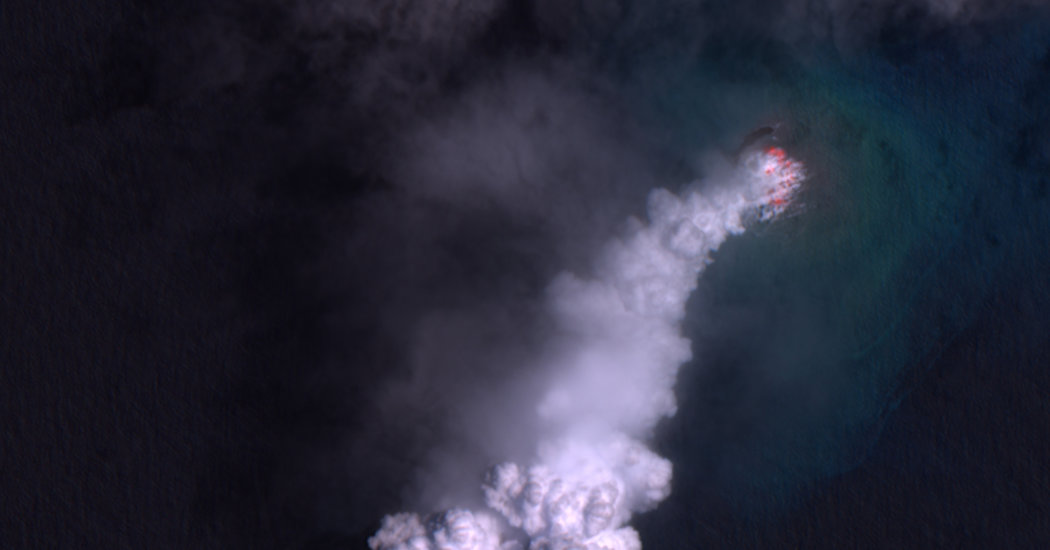Lateiki was a tiny island in the archipelagic Kingdom of Tonga, formed in 1995 by an ebullient submarine volcano. Last month, that underwater firestarter decided it was time for some explosive redecorating.
An eruption in the southwest Pacific Ocean was first reported on Oct. 14 by a Tongan ship. The Tonga Geological Service then scanned through satellite imagery and noticed the paroxysm, at Lateiki, began a day earlier. Over the next week or so, various vessels, flights and satellites intermittently saw an ashy plume rising from the island.
By Nov. 1, it was all over; Lateiki was gone, its remnants swallowed by the volcano’s erupting maw. But this loss of Tongan territory was short-lived. As quickly as Lateiki self-destructed, it was reborn as a new island roughly 400 feet to the west. The new Lateiki, 1,310 feet long and 330 feet wide, is nearly four times the size of the old one.
Lateiki is highly practiced in the art of volcanic makeovers. Several of its eruptions reportedly built ephemeral shoal islands in the 18th and 19th centuries, and more definitively in 1967 and 1979. Until 1995, these islands lasted a few months before being chewed up by the waves.
Submarine volcanism can be difficult to study and observe. But Lateiki’s cycles of death and rebirth give scientists clues to the nature of the magmatic machinations below. And with improving satellite technology, they can be documented better than ever before.
“To see this process happening in our lifetime is pretty spectacular,” said Janine Krippner of the Smithsonian Institution’s Global Volcanism Program.
Sitting midway between the islands of Kao and Late, Lateiki — formerly known as Metis Shoal — is just one member of an extended family of volcanoes. It sits on the Tonga-Kermadec volcanic arc, a 1,740-mile-long trench that delineates where the Pacific plate dives beneath the Australian plate. This titanic tectonic battle fuels many volcanoes in the southeast Pacific, from New Zealand’s North Island to the northern tip of the Tongan archipelago.
In August, an unnamed volcano along that spine erupted, producing a San Francisco-sized raft of pumice. Lateiki is just the latest fiery fountain on the arc to put on a show.
The ability of Lateiki to migrate may seem strange. But new vents can pop up anywhere along the volcano’s 3-mile long, flat-topped surface, creating islands in different locations.
“I was a little surprised that the old island completely disappeared,” said Ed Venzke, who oversees the database of volcanoes at the Global Volcanism Program.
The 1995 island had been partly eroded by waves over the past quarter-century, but nevertheless resisted complete annihilation because it was made of solid clumps of sticky, solidified lava. But the violence of October’s eruption finally seemed to cause it to collapse.
It is too early to forecast how long the new Lateiki will persist, said Brad Scott, a volcanologist at GNS Science in New Zealand. Until someone takes a closer look, it is impossible to say how easy it may be for the ocean, or another volcanic explosion, to take it out.
Its construction materials matter. Havre, another submarine volcano on that arc, erupted in 2012, producing a pumice raft 155 square miles across. But no island was created, because pumice, formed when lava quickly quenches in seawater and traps gas, is buoyant, not adhesive, and easily drifts away. Gloopy, degassed lava flows erupting at shallow depths are far better at building islands.
If the new Lateiki does stick around, it may end up like Japan’s Nishinoshima or Iceland’s Surtsey: other pop-up volcanic islands that, after the embers had cooled, became citadels of marine, microbial and avian life.
Source: Read Full Article
